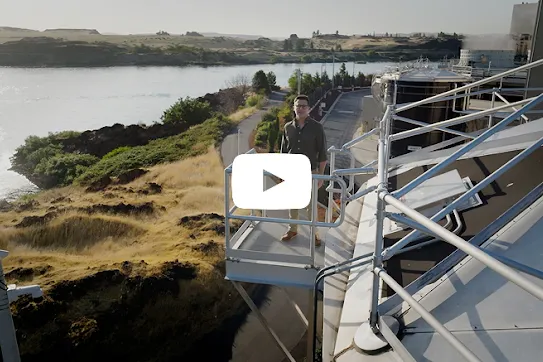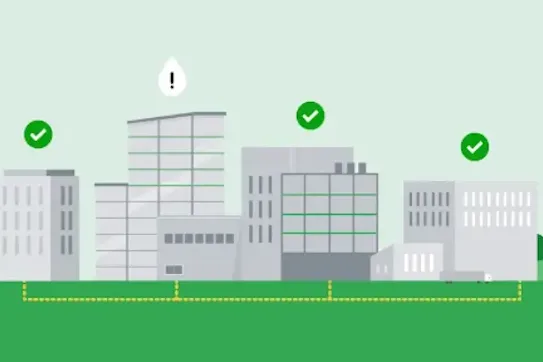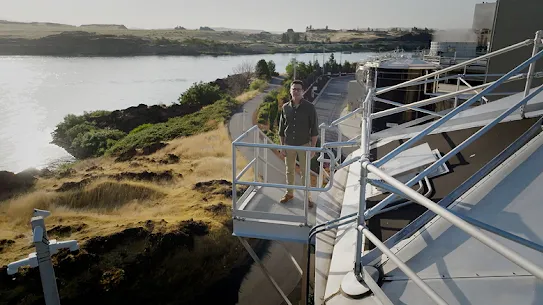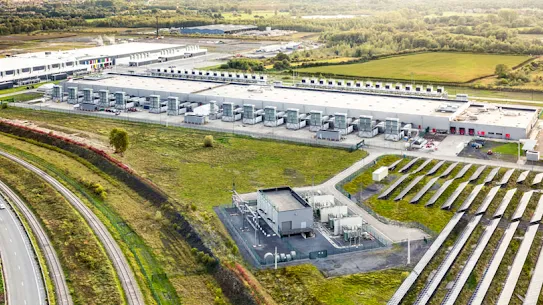Driving sustainable innovation for society
We're bringing more clean energy online and advancing responsible water use at our data centers across the globe.

Advancing sustainable water solutions at our data centers and beyond
Pursuing a holistic approach to water stewardship
Water cooling is an energy-efficient way to remove heat, and is often a more sustainable option compared to other cooling methods such as chillers or air conditioning. At each data center campus, we take a climate-conscious approach to our cooling decisions — balancing the availability of carbon-free energy and responsibly-sourced water, including alternatives to freshwater — to minimize the net climate impact both today and in the future.
Beyond our data center facilities, we seek to benefit watersheds and communities by supporting locally relevant projects that replenish our freshwater consumption and support ecosystems.

A sunset over St. Ghislain, Belgium, illuminates our water storage tanks and cooling towers.
Helping build the systems needed to power a brighter future for all
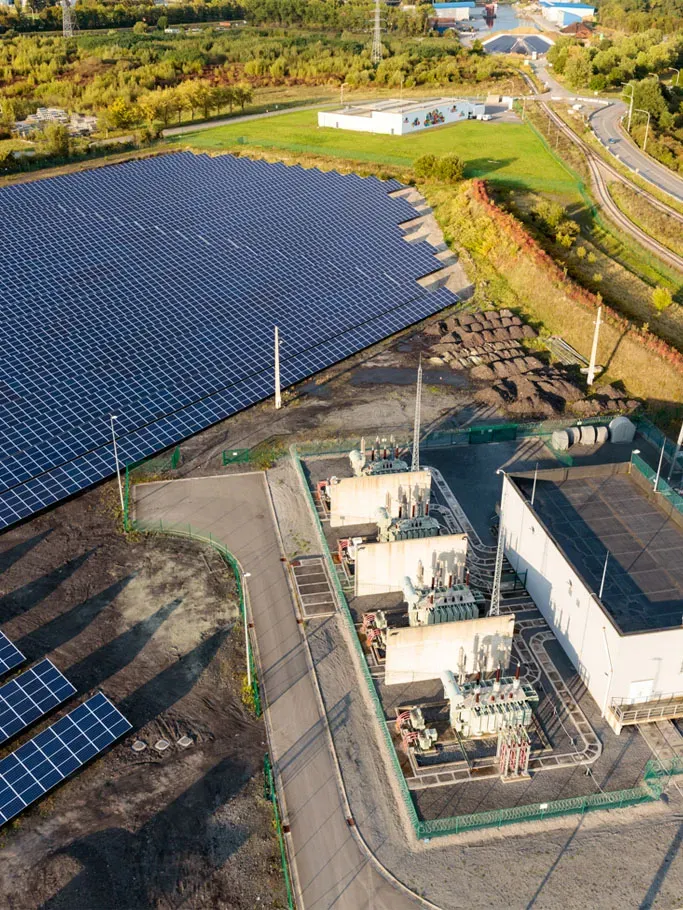
The Google solar field at our St. Ghislain, Belgium, data center.
We believe in energy solutions that benefit everyone
That’s why we prioritize affordable, reliable, and clean energy in the communities we call home. Our track record demonstrates this commitment. Since 2010, we have signed over 170 agreements to purchase more than 22 gigawatts of clean energy worldwide and invested over $3.7 billion in clean energy projects and partnerships. These efforts have allowed us to maintain a 100% renewable energy match on a global basis every year since 2017.
Ultimately, Google's ambition is to power our operations with carbon-free energy, every hour of every day. By leveraging proven technologies and investing in cutting-edge research, we are powering possibility everywhere we plug in.
Zeroing in on net-zero emissions
Reducing emissions across our operations and value chain
Data centers are a key part of Google’s journey toward net-zero carbon. We are actively working on ways to reduce the amount of greenhouse gas emissions from our data center construction by reducing the quantity of materials required to build our data centers as well as using more sustainable materials such as green concrete and renewable diesel in construction activity.
We’re leading the charge by pursuing net zero across our own operations and value chain.
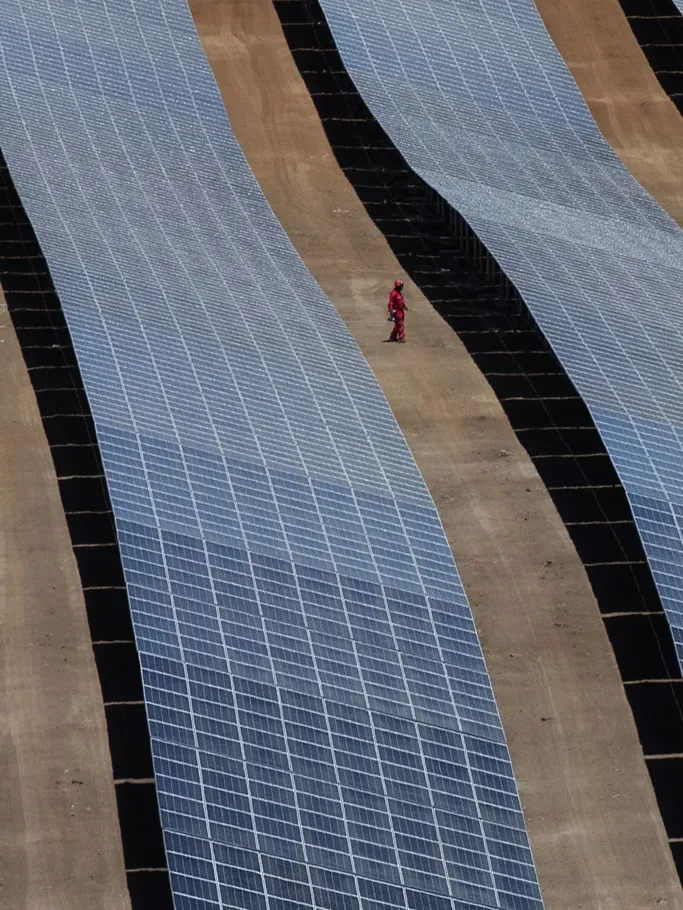
Solar power from Acciona Solar in Chile provides energy to our data center in Quilicura, Chile.
Frequently asked questions
In 2021, we set an ambition to reach net-zero emissions across all of our operations and value chain by 2030. To meet this ambition, we aim to reduce over time our absolute, combined scope 1, 2 (market-based), and 3 emissions by 50% from a 2019 base year, and we plan to invest in a range of carbon removal solutions to neutralize our remaining emissions.
A component of this moonshot is another ambition — running on 24/7 carbon-free energy on every grid where we operate by 2030.
While we’re still committed to these climate moonshots, it’s become clear that achieving them is now more complex and challenging across every level — from local to global. Several external factors, largely outside our direct control, could affect the cost, feasibility, and timeline of our progress — and navigating them requires flexibility. To maintain momentum toward our climate moonshots, we’ll continue to evaluate a broad range of solutions, balancing cost, quality, and the speed of emissions reductions.
Google is one of the world’s largest corporate buyers of clean energy and leaders in advancing clean energy technologies. In 2017, Google became the first major company to match 100% of our annual electricity consumption on a global basis with renewable energy, which we’ve achieved every year since. And in 2024, we signed contracts to purchase approximately 8 gigawatts (GW) of clean energy generation capacity — more than in any prior year in our history.
Building on our first two decades of progress, in 2020 we launched our third decade of climate action — our most ambitious yet. We have set a moonshot to reach net-zero emissions across all of our operations and value chain by 2030, supported by another climate moonshot to run on 24/7 carbon-free energy (CFE) on every grid where we operate.
We also strive to build the world’s most energy-efficient computing infrastructure, supported by responsible water use practices and a commitment to minimizing waste. Our data centers remain some of the most efficient in the world, and we continue working to optimize their use of electricity, water, and materials. In 2024, the average annual power usage effectiveness (PUE) for our global fleet of data centers was 1.09, compared with the industry average of 1.56 — meaning that Google data centers used about 84% less overhead energy for every unit of IT equipment energy.
For more details, check out our latest Environmental Report.
We buy electricity directly from new clean energy projects through various methods depending on the market, including: contracting directly via long-term power purchase agreements (PPAs); working with utilities or developers to buy and deliver carbon-free energy (CFE); structuring energy supply contracts with energy providers; and making targeted investments in renewable energy to enable additional projects on the grid. See the 2025 Environmental Report for more information.
Google is committed to being an active member in the communities we call home. Close collaboration with community leaders, local utilities, and local organizations is a priority for us to identify opportunities for meaningful community and global support.
Scaling AI and using it to accelerate climate action are just as crucial as addressing the environmental impact associated with it. To help minimize our environmental footprint, we’ve built world-leading efficient infrastructure for the AI era and use tested practices to reduce the carbon footprint of workloads.
Water plays an important role in our data centers — cooling our servers, regulating indoor temperatures, and keeping our products up and running. In fact, water cooling has been shown to help reduce energy consumption and related carbon emissions when compared to air-based cooling. While it will take more time for electricity grids to decarbonize, we’ll continue using water cooling to improve our energy efficiency in certain geographies. Recognizing that this tradeoff will increase our data center water footprint, we’re prioritizing responsible water use and water replenishment at new sites from the start.


In consultation with a team of water experts, Google developed a peer-reviewed, context-based Water Risk Framework to evaluate local watershed risk at new sites to guide decision-making on whether to use a freshwater source for evaporative cooling.
Google aims to “return” or improve the water quality and ecosystem health in the watersheds and communities where we operate through investments in water stewardship projects.
